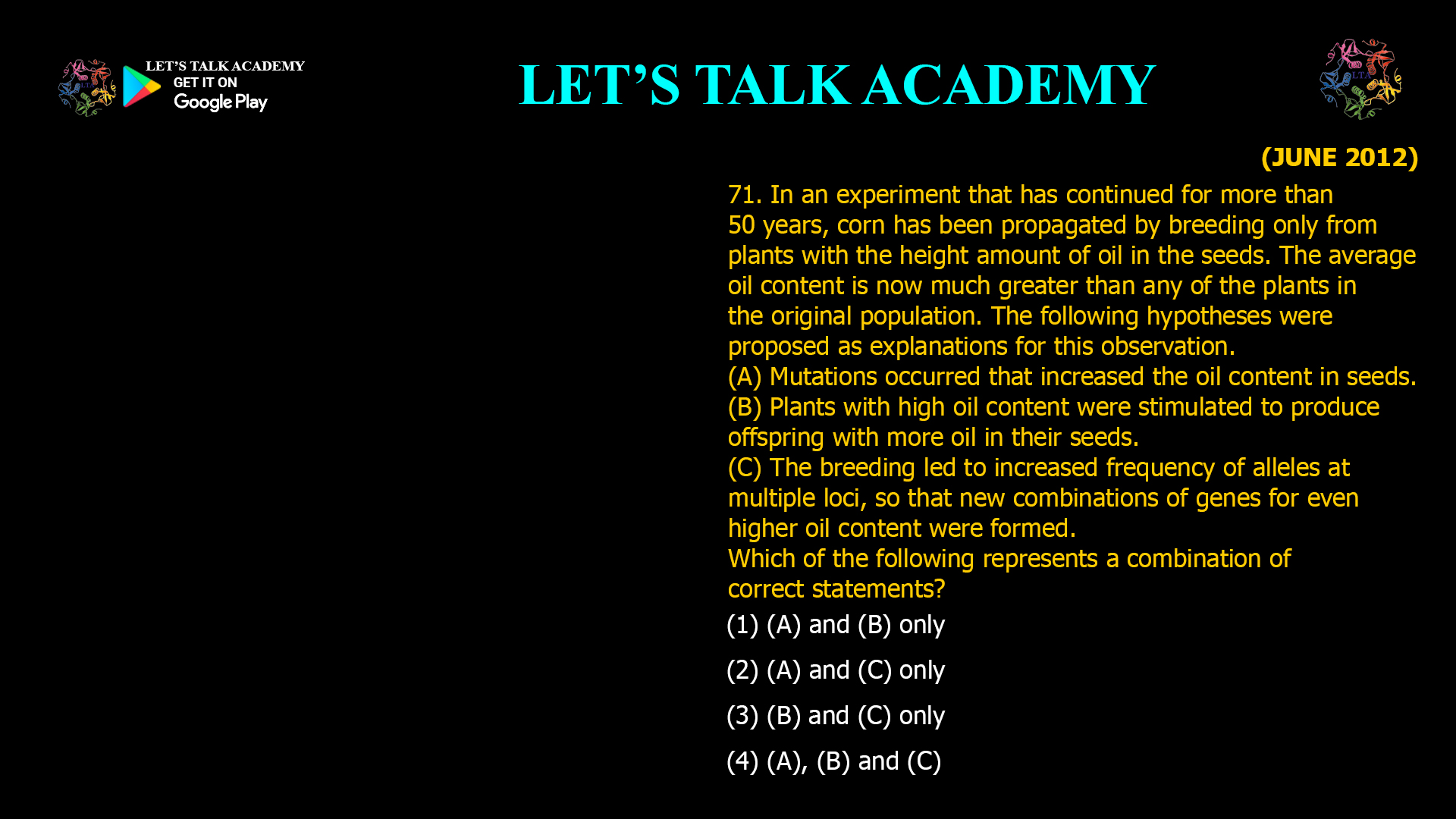- In an experiment that has continued for more than 50 years, corn has been propagated by breeding only from plants with the height amount of oil in the seeds. The average oil content is now much greater than any of the plants in the original population. The following hypotheses were proposed as explanations for this observation.
(A) Mutations occurred that increased the oil content in seeds.
(B) Plants with high oil content were stimulated to produce offspring with more oil in their seeds.
(C) The breeding led to increased frequency of alleles at multiple loci, so that new combinations of genes for even higher oil content were formed.
Which of the following represents a combination of correct statements?
(1) (A) and (B) only (2) (A) and (C) only
(3) (B) and (C) only (4) (A), (B) and (C)The Experiment: Selective Breeding for High Oil Content
The Illinois Long-Term Selection Experiment is one of the most famous examples of sustained artificial selection in plants. Beginning in 1896, researchers started with a genetically diverse population of corn and, each generation, selected seeds from the plants with the highest oil content to parent the next generation. Over many generations, the average oil content in the seeds increased dramatically, sometimes reaching levels several times higher than those found in the original population.
Hypotheses to Explain Increased Oil Content
Three main hypotheses have been proposed to explain why the oil content increased so much:
(A) Mutations occurred that increased the oil content in seeds.
(B) Plants with high oil content were stimulated to produce offspring with more oil in their seeds.
(C) The breeding led to increased frequency of alleles at multiple loci, so that new combinations of genes for even higher oil content were formed.Let’s examine each in the context of modern genetics and the results of long-term selection experiments.
Hypothesis A: Mutations Increased Oil Content
Over the course of many generations, new mutations can arise randomly in a population. If a mutation happens to increase oil content, and those plants are consistently selected, the mutation can spread and become common. This is a well-established mechanism in evolutionary genetics: mutation provides new genetic variation, and selection can increase the frequency of beneficial mutations.
Hypothesis B: Stimulation of High Oil Content Offspring
This hypothesis suggests that simply being a high-oil plant somehow stimulates the production of even higher-oil offspring, independent of genetic inheritance. This idea is not supported by genetic evidence. Modern genetics demonstrates that traits like oil content are inherited based on gene combinations, not by a plant’s physiological state stimulating specific changes in its offspring. There is no credible mechanism by which a plant’s phenotype alone can direct the next generation’s genetic makeup in this way.
Hypothesis C: Increased Frequency and Recombination of Favorable Alleles
Selective breeding works by increasing the frequency of alleles (gene variants) that contribute to the desired trait—in this case, high oil content. Over many generations, selection can also bring together favorable alleles at multiple genetic loci, creating new combinations that produce even higher oil content than seen in the original population. This is a classic example of how artificial selection can drive rapid evolutionary change by reshuffling and concentrating existing genetic variation.
Which Hypotheses Are Correct?
Based on decades of research and the principles of genetics, the correct explanations are (A) and (C):
-
New mutations (A) can introduce alleles that further increase oil content, and these mutations can be captured by ongoing selection.
-
Selective breeding (C) increases the frequency of favorable alleles at multiple loci, and recombination can bring these alleles together in new, more productive combinations than existed in the starting population.
Hypothesis (B) is not correct because there is no scientific evidence that a plant’s phenotype can directly stimulate its offspring to exceed its own trait value outside of genetic inheritance.
Supporting Evidence from Long-Term Corn Selection
-
Genetic studies have shown that traits like oil content are controlled by many genes (polygenic), and long-term selection can steadily increase the frequency of favorable alleles and create new, superior gene combinations.
-
Mutation and recombination both contribute to the ongoing response to selection, even after many generations.
-
No evidence supports the idea that plants can “stimulate” their offspring to be better outside of genetic mechanisms.
Table: Evaluation of Hypotheses
Hypothesis Supported by Evidence? Explanation (A) Mutations increased oil content Yes New beneficial mutations can arise and be selected over generations. (B) Stimulation of high-oil offspring No No genetic mechanism supports this; inheritance is genetic, not physiological. (C) Increased frequency and recombination of favorable alleles Yes Selective breeding increases favorable alleles and creates new gene combinations. Conclusion
The dramatic increase in corn oil content after decades of selective breeding is best explained by two mechanisms: the accumulation of new beneficial mutations and the increased frequency and combination of favorable alleles at multiple genetic loci. These processes, driven by artificial selection, have allowed breeders to surpass the oil content of any original plant in the population. The idea that plants can stimulate their offspring to produce more oil, independent of genetics, is not supported by scientific evidence.
The correct combination of explanations is (A) and (C) only.
-



